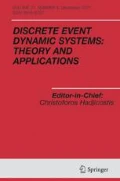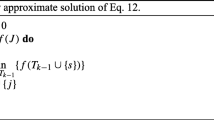Abstract
Based on the (min,+)-linear system theory, the work developed here takes the set membership approach as a starting point in order to obtain a container for ultimately pseudo-periodic functions representative of Discrete Event Dynamic Systems. Such a container, by approximating the exact system, ensures to entirely include it in a guaranteed way. To reach that point, the container introduced in this paper is given as an interval, the bounds of which are a convex function for the upper approximation and a concave function for the lower approximation. Thanks to the characteristics of the bounds, the aim is both to reduce data storage (that can be very high when exact functions are handled) and to reduce the algorithm complexity of the operations of sum, inf-convolution and subadditive closure. These operations are integrated into inclusion functions, the algorithms of which are of linear or quasi-linear complexity.
















Similar content being viewed by others
Notes
Name of a research project dealing with COmputational Issues in Network Calculus.
Operation used for the concatenation of systems.
Also called Kleene star operation and used for systems with closed-loop architecture.
Also called the convex conjugate function.
Created with the container and the algorithms described in this paper.
Which can be seen as “signals” for DEDS.
Subclass of Timed Petri Nets in which each place has exactly one upstream and one downstream transition.
As in the usual algebra, operator ⊗ can be omitted: ab = a ⊗ b.
This designation is different according to the context of use: Network Calculus or TEG.
Which is made in the MinMaxGD toolbox.
The affine parts are linked by non-differentiable points.
The epigraph of a convex function is a convex set.
The hypograph of a concave function is a convex set.
\(\mathcal{D}_{convex}\) is the set of convex functions endowed with the pointwise maximum as sum and the pointwise addition as product.
On ]τ f , + ∞ [.
These designations come from the Network Calculus.
The sorting of the function slopes is assumed to be made by the data structure used for their representation.
The construction of a container f from one elementary function \(\Delta_{T}^{K}\) provides two identical bounds \(\underline{f} = \overline{f}\) with only one extremal point of (T,K) coordinates, and an infinite asymptotic slope \(\sigma(\underline{f}) = \sigma(\overline{f}) = +\infty\).
References
Baccelli F, Cohen G, Olsder GJ, Quadrat J-P (1992) Synchronization and linearity: an algebra for discrete event systems. Wiley, New York
Bouillard A, Thierry E (2008) An algorithmic toolbox for Network Calculus. Discrete Event Dyn Syst 18(1):3–49
Bouillard A, Gaujal B, Lagrange S, Thierry E (2007) Optimal routing for end-to-end guarantees: the price of multiplexing. In: Proceedings of the 2nd international conference on performance evaluation methodologies and tools, ValueTools’07. ICST (Institute for Computer Sciences, Social-Informatics and Telecommunications Engineering), pp 1–10
Bouillard A, Jouhet L, Thierry E (2008) Computation of a (min,+) multi-dimensional convolution for end-to-end performance analysis. In: Proceedings of the 3rd international conference on performance evaluation methodologies and tools, ValueTools’08. ICST (Institute for Computer Sciences, Social-Informatics and Telecommunications Engineering), pp 1–7
Bouillard A, Cottenceau B, Gaujal B, Hardouin L, Lagrange S, Lhommeau M (2009) COINC library: a toolbox for the network calculus. In: Proceedings of the 4th international conference on performance evaluation methodologies and tools, ValueTools’09. ICST (Institute for Computer Sciences, Social-Informatics and Telecommunications Engineering)
Boyer M (2010) Nc-maude: a rewriting tool to play with Network Calculus. In: Leveraging applications of formal methods, verification, and validation: 4th international symposium on leveraging applications, Isola’10. Springer, pp 137–151
Burkard RE, Butkovič P (2003) Finding all essential terms of a characteristic maxpolynomial. Discrete Appl Math 130(3):367–380
Chang CS (2000) Performance guarantees in communication networks. Springer, Berlin
Cohen G, Gaubert S, Nikoukhah R, Quadrat J-P (1989a) Convex analysis and spectral analysis of timed event graphs. In: Proceedings of the 28th IEEE conference on decision and control, CDC’89. IEEE, pp 1515–1520
Cohen G, Moller P, Quadrat J-P, Viot M (1989b) Algebraic tools for the performance evaluation of discrete event systems. Proc IEEE 77(1):39–85
Conway JH (1971) Regular algebra and finite machines. Chapman, Boston
Cottenceau B (1999) Contribution à la commande de systèmes à événements discrets: synthèse de correcteurs pour les graphes d’événements temporisés dans les dioïdes. PhD thesis, LISA—Université d’Angers. http://www.istia.univ-angers.fr/LISA/THESES/theses.html
Cottenceau B, Hardouin L, Lhommeau M (1998–2006) MinMaxGD, une librairie de calculs dans \( \mathcal{M}_{\text{in}}^{\text{ax}} \left[\kern-0.15em\left[ {\gamma ,\delta } \right]\kern-0.15em\right] \). Tech rep, http://www.istia.univ-angers.fr/~hardouin/
Cottenceau B, Lhommeau M, Hardouin L, Boimond J-L (2000) Data processing tool for calculation in dioid. In: 5th international workshop on discrete event systems. WODES’00. http://www.istia.univ-angers.fr/~hardouin/
Cottenceau B, Hardouin L, Boimond J-L, Ferrier J-L (2001) Model reference control for timed event graphs in dioids. Automatica 37(9):1451–1458
Fidler M, Recker S (2006) Conjugate Network Calculus: a dual approach applying the Legendre transform. Comput Networks 50(8):1026–1039
Gaubert S (1992) Théorie des systèmes linéaires dans les dioïdes. PhD thesis, INRIA—Ecole des Mines de Paris. http://amadeus.inria.fr/gaubert/PAPERS/ALL.pdf
Graham RL (1972) An efficient algorithm for determining the convex hull of a finite planar set. Inf Process Lett 1(4):132–133
Hardouin L, Cottenceau B, Lhommeau M, Le Corronc E (2009) Interval systems over idempotent semiring. Linear Algebra Appl 431(5–7):855–862
Heidergott B, Olsder GJ, van der Woude J (2006) Max plus at work, modeling and analysis of synchronized systems: a course on max-plus algebra and its applications. Princeton University Press, Princeton
Jaulin L, Kieffer M, Didrit O, Walter E (2001) Applied interval analysis. Springer, London
Krob D (1990) A complete system of b-rational identities. Lect Notes Comput Sci 443/1990:60–73
Le Boudec J-Y, Thiran P (2001) Network Calculus: a theory of deterministic queuing systems for the internet. Springer, Berlin
Le Corronc E (2011) Modèles et calculs garantis pour les systèmes (min,+)-linéaires. PhD thesis, LISA—Université d’Angers. http://www.istia.univ-angers.fr/LISA/THESES/theses.html
Le Corronc E, Cottenceau B, Hardouin L (2010) Flow control with (min,+) algebra. In: 4th international symposium on leveraging applications of formal methods, verification and validation, special session worst case traversal time. ISOLA’10
Lenzini L, Martorini L, Mingozzi E, Stea G (2006) Tight end-to-end per-flow delay bounds in fifo multiplexing sink-tree networks. Perform Eval 63(9–10):956–987
Lhommeau M, Hardouin L, Ferrier J-L, Ouerghi I (2005) Interval analysis in dioid: application to robust open-loop control for timed event graphs. In: 44th IEEE conference on decision and control and European control conference. CDC-ECC’05, pp 7744–7749
Litvinov GL, Sobolevskiī AN (2001) Idempotent interval analysis and optimization problems. Reliab Comput 7(5):353–377
Maia CA, Hardouin L, Santos-Mendes R, Cottenceau B (2003) Optimal closed-loop control of timed event graphs in dioids. IEEE Trans Automat Contr 48(12):2284–2287
Moore RE (1979) Methods and applications of interval analysis. SIAM, Philadelphia
Olsder GJ, Subiono, Mac Gettrick M (1998) On large scale max-plus algebra model in railway systems. In: Algèbres Max-Plus et applications en informatique et automatique, École de printemps d’informatique théorique, Noirmoutier
Pandit K, Schmitt J, Kirchner C, Steinmetz R (2006) A transform for network calculus and its application to multimedia networking. In: Proceedings of SPIE on multimedia computing and networking. MMCN’06, vol 6071, pp 103–114
Rockafellar RT (1997) Convex analysis. Princeton University Press, Princeton
Schmitt JB, Zdarsky FA (2006) The disco network calculator: a toolbox for worst case analysis. In: Proceedings of the 1st international conference on performance evaluation methodologies and tools, ValueTools’06. ACM
Wandeler E, Thiele L (2006) Real-time calculus (rtc) toolbox. http://www.mpa.ethz.ch/Rtctoolbox
Author information
Authors and Affiliations
Corresponding author
Rights and permissions
About this article
Cite this article
Le Corronc, E., Cottenceau, B. & Hardouin, L. Container of (min, +)-linear systems. Discrete Event Dyn Syst 24, 15–52 (2014). https://doi.org/10.1007/s10626-012-0148-9
Received:
Accepted:
Published:
Issue Date:
DOI: https://doi.org/10.1007/s10626-012-0148-9



